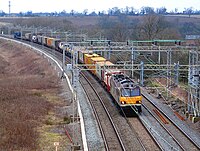
Photo from wikipedia
IntroductionIn recent years there have been major changes in the composition of cargo to the point where, in Europe, semi-finished products (e.g. car parts) and finished goods represent the greatest… Click to show full abstract
IntroductionIn recent years there have been major changes in the composition of cargo to the point where, in Europe, semi-finished products (e.g. car parts) and finished goods represent the greatest transport demand. This type of cargo is typically of lower density and higher value (LDHV) than previous goods and requires faster and more reliable transportation. Currently, LDHV goods are predominantly transported by road.MethodologyThis research applies qualitative approach with an online survey consisting of 24 industry experts in assessing the ‘existing’ solutions for competitive rail freight service operation for LDHV cargoes, plus the proposed ‘future’ (i.e. in 7 years’ time). The results are presented in the form of a ‘GAP’ analysis that examined three core themes: ‘wagon’, ‘train and hubs’ and ‘business quality and planning’.ResultsThe study finds that, under the theme of wagon, the provision of an electrical power supply to each individual rail freight wagon is deemed important. In the train and hubs theme, the research suggests that greater importance is assigned to terminal access and functionality, rather than their overall cargo handling capabilities. In the business quality and planning theme, one issue in particular stood out: the ability to freely integrate freight and passenger services; this is considered a key requirement of the railways of the future.ConclusionThis research contributes significantly to the field by demonstrating that the desire to transport LDHV goods by rail freight has potential. There are difficulties in integrating freight and passenger services, but technical innovation can allow freight services to operate at similar performance levels to passenger services. This research has identified a number of such technical innovations. It is envisaged that the adoption of these innovations, by the rail industry, will lead to a modal shift from road to rail for the transport of LDHV goods. The analysis suggests that the emerging technologies presented in the survey (e.g. horizontal transhipment) have the capability to promote modal shift by directly strengthening the rail freight service offering, as an alternative to less sustainable modes such as road. Finally the research is revelatory in that this topic has not been addressed by academia nor the industry previously, and has identified future research gaps and questions with potential impact that researchers can look to answer in the future.
Journal Title: European Transport Research Review
Year Published: 2017
Link to full text (if available)
Share on Social Media: Sign Up to like & get
recommendations!